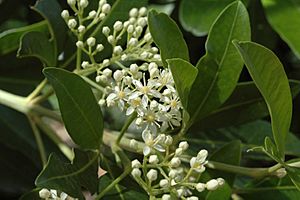Yellow satinheart facts for kids
For another Australian rainforest tree known as Bonewood, see Emmenosperma alphitonioides.
Quick facts for kids Yellow satinheart |
|
|---|---|
 |
|
| In Australian National Botanic Gardens | |
| Scientific classification | |
| Genus: |
Acradenia
|
| Species: |
euodiiformis
|
| Synonyms | |
|
|
The Yellow Satinheart (scientific name: Acradenia euodiiformis) is a special type of tree found only in eastern Australia. It's also sometimes called Bonewood. This tree usually has leaves made of three smaller leaflets, which are narrow and shaped like a spear. These leaves have tiny oil glands that you can see. The Yellow Satinheart also grows beautiful white flowers in clusters. You can find this tree growing in and around rainforests.
Contents
What Does the Yellow Satinheart Tree Look Like?
The Yellow Satinheart is a medium to large tree. It typically grows to be about 12 to 30 meters (around 40 to 100 feet) tall. Its trunk can be up to 60 centimeters (about 2 feet) wide. The trunk is often not perfectly round and can have a few stems.
Bark and Leaves
The bark of the Yellow Satinheart tree is usually smooth and creamy in color. It can feel a bit corky and has vertical lines of small bumps. If you look at the living bark underneath, you might see patterns of red and cream colors.
The leaves grow in pairs on opposite sides of the branch. Most leaves have three leaflets, but sometimes they can have two or five. Each leaflet is usually 50 to 180 millimeters (about 2 to 7 inches) long and 15 to 50 millimeters (about 0.6 to 2 inches) wide. The leaves are smooth and have large, easy-to-see oil glands.
Flowers and Fruit
The flowers of the Yellow Satinheart grow in groups called panicles, which are 60 to 210 millimeters (about 2 to 8 inches) long. The small sepals (leaf-like parts that protect the flower bud) are about 1 to 1.5 millimeters long and have tiny hairs. The petals are white or cream-colored and are about 3.5 to 5.5 millimeters long with soft, woolly hairs.
You can see the flowers from September to January. After the flowers, the tree produces fruits that ripen in January. These fruits are called follicles and are about 6 to 8 millimeters long with ribs on them.
How Was the Yellow Satinheart Tree Named?
The Yellow Satinheart was first officially described in 1875. A scientist named Ferdinand von Mueller gave it the name Bosistoa euodiiformis. He described it in his book Fragmenta phytographiae Australiae. The specimens he used were collected near the Clarence River by Mary Anne Wilcox.
Later, in 1977, another scientist named Thomas Gordon Hartley changed the tree's name to Acradenia euodiiformis. This new name was published in the Journal of the Arnold Arboretum.
Where Does the Yellow Satinheart Tree Grow?
The Yellow Satinheart tree grows naturally in rainforests and along the edges of rainforests. You can find it from the McPherson Range in southeastern Queensland down to the Hunter River in New South Wales. It grows at different heights, from 60 meters (about 200 feet) up to 1200 meters (about 4000 feet) above sea level.
This tree is often seen growing as a smaller tree under the taller trees in rainforests. It especially likes to grow in poorer soils that come from sedimentary rocks and along creeks. However, it can also be found in more fertile soils that come from volcanic basalt and at higher altitudes.
Images for kids
See also
 In Spanish: Acradenia euodiiformis para niños
In Spanish: Acradenia euodiiformis para niños


